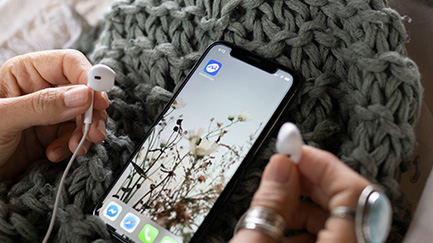Like all of us, children and teenagers are learning to navigate something they’ve never known before. They are also hearing different information about COVID-19 and quite naturally might have some questions. Finding a supportive yet honest way to talk to them about COVID-19 can help protect them and reduce their fear.
Here are some easy steps to help guide you through a conversation with your children or teenagers.
Find out what they already know:
- Ask questions geared to your child’s age level. For older children this might be, “Are your friend’s talking about coronavirus? What are they saying?” For younger children you might ask, “Have you heard grownups talking about a new sickness that’s going around?” This allows you to learn what they already know and any misinformation they are hearing.
- Follow your child’s lead. If they don’t seem interested or don’t ask a lot of questions, that’s okay.
Offer comfort and honesty:
- If they are interested, encourage them to share their concerns and let them know that they have parents and teachers to discuss their thoughts and feelings with. Focus on helping your child feel safe but be honest. If they asked you a question you don’t know the answer to, say so. You can use the question as a chance to find out together. There are a number of ways to get up to date, reliable information about COVID-19 including at health.gov.au and healthdirect.gov.au. Using these websites will help you stick to the facts and kids don’t see headlines about death and other scary information.
- The way a parent behaves can have a significant impact on a child. Keep conversations calm and focussed on facts. Show you are listening, and that their concerns are important to you. Remind them that you are there to look after them. Explain that China has done a good job researching and understanding the virus and is now coming out the other side and so will we.
Phrases you can use to talk to young children include:
- COVID-19 is a disease caused by a new germ or bug.
- Germs are very tiny and can make us sick if they get into our bodies.
- You cannot see germs with your eyes (only under a microscope).
- The germ that causes COVID-19 spreads easily from person to person and infects the breathing system, our nose, throat and lungs.
- It is passed from person to person through tiny droplets when people cough or sneeze.
- These droplets can be breathed in by others – which is why we should try not to get too close to others and cover our sneezes and coughs with our arm or a tissue. Then wash our hands.
- The droplets might land on surfaces, like phones, door handles, tables and hands. If we shake someone’s hand or touch these things and then touch our eyes, mouth or nose, the germ can get inside us.
- We need to try not to touch our face, avoid shaking hands and wash our hands often, especially before eating (when we put our fingers to our mouth).
- Most kids won’t get very sick if they get COVID-19. If they do it will be a bit like getting a cold. If they want to understand the immune system here is a visual they might like.
- The disease is more serious in old people and those that have other sicknesses already.
- We all need to do what we can to stop the germ spreading to keep it away from old/sick people.
Discuss what’s within our control:
- Let them know that if we listen to health professionals, we can follow the behaviours they suggest.
- Model health-promoting behaviours. Teach them how to wash their hands.
- Talk about what’s happening to keep people safe and healthy. For younger children, it might be reassuring them that there are doctors, nurses and hospitals to help us if we get sick. For older children they might be comforted by scientists working to develop a vaccine.
- Remember that children and teenagers often worry more about family and friends than themselves. For example, if your child is worried about their grandparents let them Skype or call them to help them feel reassured.
- Let your kids know that it’s normal to feel stressed out at times. Everyone does. By recognising these feelings and knowing that stressful times will pass, and life will go back to normal, can help children build resilience. Understand that they may not be able to verbalise their anxiety and confusion. These feelings may be expressed in a variety of ways. For example, they may become clingy or withdrawn; increase their aggressiveness or return to outgrown behaviours such as thumb sucking or carrying a cuddly toy. If you child or teenager needs further support, there are many organisations that can help, including kidshelpline.com.au.
If you child or teenager needs further support, there are many organisations that can help, including
kidshelpline.com.au.





